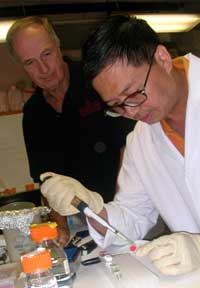Athens, Georgia
September 26, 2006
Source:
Georgia
Faces
The University of Georgia
College of Agricultural and Environmental Sciences
By Stephanie Schupska
University of Georgia
Root-knot nematodes attack
nearly every crop grown.
University of Georgia
experts found a way to
stop them.
University of Georgia professor Richard Hussey has spent 20
years studying a worm-shaped parasite too small to see without a
microscope. His discovery is vastly bigger. Hussey and his
research team have found a way to halt the damage caused by one
of the world’s most destructive groups of plant pathogens.
 |
|
Richard Hussey, left, looks on as Guozhong Huang
continues his research on nematodes. Hussey and
Huang teamed up to find a way to halt food and
fiber crop damage caused by root-knot nematodes. |
|
Photo: Stephanie Schupska/UGA |
|
University of Georgia professor
Richard Hussey has spent 20 years studying a worm-shaped
parasite too small to see without a microscope. His discovery is
vastly bigger.
Hussey and his research team
have found a way to halt the damage caused by one of the world’s
most destructive groups of plant pathogens.
Root-knot nematodes are the
most economically important group of plant-parasitic nematodes
worldwide, said Hussey, a distinguished research professor in
plant pathology at the UGA College of Agricultural and
Environmental Sciences.
They attack nearly every food
and fiber crop grown, about 2,000 plant species in all. The
nematode invades plant roots, and by feeding on the roots’
cells, they cause the roots to grow large galls, or knots,
damaging the crop and reducing its yields.
Working with assistant research
scientist Guozhong Huang and research technician Rex Allen,
Hussey discovered how to make plants resistant to root-knot
nematode infection.
Eric Davis at North Carolina
State University and Thomas Baum at Iowa State University also
collaborated on the research.
The discovery “has the
potential to revolutionize root-knot resistance in all crops,”
Hussey said.
The most cost-effective and
sustainable management tactic for preventing root- knot nematode
damage and reducing growers’ losses, he said, is to develop
resistant plants that prevent the nematode from feeding on the
roots. Because root- knot nematode resistance doesn’t come
naturally in most crops, Hussey’s group bioengineered their own.
Engineering broad root-knot resistance in transgenic
plants by RNAi silencing of a conserved and essential
root-knot nematode parasitism gene
Guozhong Huang, Rex Allen, Eric L. Davis, Thomas J.
Baum, and Richard S. Hussey
ABSTRACTSecreted
parasitism proteins encoded by parasitism genes
expressed in esophageal gland cells mediate infection
and parasitism of plants by root-knot nematodes (RKN).
Parasitism gene 16D10 encodes a conserved RKN secretory
peptide that stimulates root growth and functions as a
ligand for a putative plant transcription factor. We
used in vitro and in vivo RNA interference approaches to
silence this parasitism gene in RKN and validate that
the parasitism gene has an essential function in RKN
parasitism of plants. Ingestion of 16D10 dsRNA in vitro
silenced the target parasitism gene in RKN and resulted
in reduced nematode infectivity. In vivo expression of
16D10 dsRNA in Arabidopsis resulted in resistance
effective against the four major RKN species. Because no
known natural resistance gene has this wide effective
range of RKN resistance, bioengineering crops expressing
dsRNA that silence target RKN parasitism genes to
disrupt the parasitic process represents a viable and
flexible means of developing novel durable RKN-resistant
crops and could provide crops with unprecedented broad
resistance to RKN.
Freely available
online through the PNAS open access option.
http://www.pnas.org/cgi/content/full/103/39/14302 |
The results of the study were
published Sept. 26 in the journal,
Proceedings of the National Academy of Sciences.
Four common root-knot nematode
species account for 95 percent of all infestations in
agricultural land. By discovering a root-knot nematode
parasitism gene that’s essential for the nematode to infect
crops, the scientists have developed a resistance gene effective
against all four species.
Using a technique called RNA
interference, the researchers have effectively turned the
nematode’s biology against itself. They genetically modified
Arabidopsis, a model plant, to produce double-stranded RNA to
knock out the specific parasitism gene in the nematode when it
feeds on the plant roots.
This knocked out the parasitism
gene in the nematode and disrupted its ability to infect plants.
“No natural root-knot
resistance gene has this effective range of root-knot nematode
resistance,” Hussey said.
The researchers’ efforts have
been directed primarily at understanding the molecular tools the
nematode uses to infect plants. This is a prerequisite for
bioengineering durable resistance to these nematodes in crop
plants.
Through this research, they’ve
discovered the parasitism genes that make a nematode a plant
parasite so it can attack and feed on crops, Huang said.
“Our results of in-plant RNA
interference silencing of a parasitism gene in root-knot
nematodes provides a way to development crops with broad
resistance to this destructive pathogen,” Hussey said. “Equally
important, our approach makes available a strategy for
developing root-knot-nematode-resistant crops for which natural
resistance genes do not exist.”
Funding for the project came
from the U.S. Department of Agriculture’s Cooperative State
Research, Education and Extension Service National Research
Initiative and the UGA CAES.
RELATED RELEASE:
Researchers design a new way to make plants
resistant to root-knot nematode |